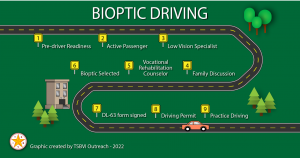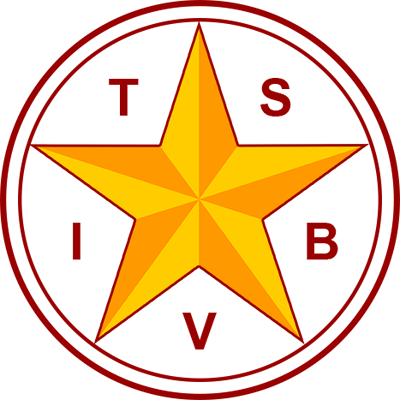The Driving Question for Students with Low Vision
Authors: Cindy Bachofer, Low Vision Consultant, Texas School for the Blind and Visually Impaired (TSBVI)
Keywords: driving, bioptic, Low Vision Specialist, Texas Workforce Commission, Certified Driving Rehabilitation Specialist, Certified Orientation and Mobility Specialist, pre-driver readiness skills
Listen to the Article
For most teenagers, driving is not only a dream but a rite of passage. Students with low vision often wonder, “Will I be able to drive?” Finding an answer to this question is a complex equation of gathering facts, making decisions, and facing emotional issues of these students and their families. As passengers in the car, children grow up watching their friends and family members at the wheel and believe that driving is as easy as the experienced driver makes it look. Driving is a demanding task, however. Vision is only one of multiple components needed to be a safe and effective driver. Other factors such as quick reaction time, rapid decision-making, extended attention, and motor coordination are also essential. Some drivers will need to use a bioptic, a telescopic lens system mounted on glasses frames, to qualify to drive. A number of professionals can assist in learning about and obtaining the bioptic:
- The Low Vision Specialist prescribes the bioptic
- In Texas, funding for the bioptic may be available through the Texas Workforce Commission (TWC)
- The Certified Driving Rehabilitation Specialist (CDRS) provides additional in-car training while adjusting to the bioptic
Setting aside time for discussing the decision of getting a driver’s license and learning the steps to follow (see below) is important for potential drivers with low vision and their families.
A free resource now available at TSBVI Online Learning is the e-course Bioptic Driving. This course includes a Foundations module and three additional modules specifically for students, family members, and professionals in the field of visual impairment and related agencies (e.g., TWC, Department of Public Safety). The Foundations module gives an overview of the topic, including visual criteria to drive in Texas and how the bioptic is used. Continuing education credit is available for those completing the VI professional module. This link takes you to the online course and provides information on setting up a learner account in Bridge, TSBVI’s Learning Management System. A Frequently Asked Questions (FAQs) document is located in the Resources list provided at the end of each module. For further information on taking the course, contact Steven Landry, Outreach Training Specialist at landrys@tsbvi.edu.
The infographic below presents the nine steps to licensure:

A detailed diagram showing the nine steps for acquiring a driver’s license for students with low vision.
Getting ready to drive begins long before the teenage years. Parents and guardians should work with the student’s Certified Orientation and Mobility Specialist (COMS) to help a young person become pre-driver ready. Knowing how to travel independently on foot is a pre-cursor to getting behind the wheel. Examples of pre-driver readiness skills include:
- Follow multi-step directions to reach a destination and reverse the route.
- Anticipate changes in the path of travel through use of eye lead (looking ahead) and visual scanning of the environment.
- Analyze different types of intersections to understand traffic patterns and timing for crossing safely.
A child needs lots of experience in different settings with increasing independence to develop confidence as a safe and efficient on foot traveler. Further explanation of pre-driver readiness skills is available at the link below.
Step by Step Guide to Pre-Driver Readiness
Many can easily remember the day and the feeling of first getting their driver’s license. It represented independence and adulthood. For the young person with low vision it starts with asking the question, “Will I be able to drive?” The steps to licensure outlined in the e-course Bioptic Driving will help you get that answer. The young driver at last can hear those words, “Grab the car keys—Let’s go! “
